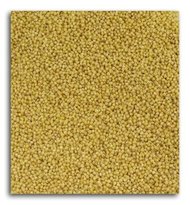
Millet is tiny in size and round in shape and can be white, gray, yellow or red. The most widely available form of millet found in stores is the hulled variety, although traditional couscous made from cracked millet can also be found. The term millet refers to a variety of grains, some of which do not belong to the same genus.
Millet is widely grown around the world as cereal crops or grains for both human food and animal consumption. We usually use millet in this country as bird seed, but it's becoming more common in health food stores. The most widely grown millet is pearl millet, which is an important crop in India and parts of Africa. It will grow where little else will survive. If does not require good soil and very little moisture to grow.
Health Benefits:
Millet is a good source of some very important nutrients, including manganese, phosphorus, and magnesium.
Heart-Protective Properties...Magnesium
Although oats have been widely publicized for their heart-protective properties, millet is a grain that should also be included on your list of heart-healthy choices because of its status as a good source of magnesium. Magnesium has been shown in studies to reduce the severity of asthma and to reduce the frequency of migraine attacks. Magnesium has also been shown to lower high blood pressure and reduce the risk of heart attack, especially in people with atherosclerosis or diabetic heart disease. Niacin (vitamin B3) can be of help in lowering high cholesterol.
Development and Repair of Body Tissue...Phosphorus
Phosphorus plays a role in the structure of every cell in the body. In addition to its role in forming the mineral matrix of bone, phosphorus is an essential component of numerous other life-critical compounds. Phosphorus is an important component of nucleic acids, the building blocks of the genetic code. In addition, the metabolism of lipids (fats) relies on phosphorus, and phosphorus is an essential component of lipid-containing structures such as cell membranes and nervous system structures. A cup of cooked millet will give you 17% of the daily value for phosphorus.
Millet and Other Whole Grains Substantially Lower Type 2 Diabetes Risk
Millet and other whole grains are a rich source of magnesium, a mineral that acts as a co-factor for more than 300 enzymes, including enzymes involved in the body's use of glucose and insulin secretion.
Millet is widely grown around the world as cereal crops or grains for both human food and animal consumption. We usually use millet in this country as bird seed, but it's becoming more common in health food stores. The most widely grown millet is pearl millet, which is an important crop in India and parts of Africa. It will grow where little else will survive. If does not require good soil and very little moisture to grow.
Health Benefits:
Millet is a good source of some very important nutrients, including manganese, phosphorus, and magnesium.
Heart-Protective Properties...Magnesium
Although oats have been widely publicized for their heart-protective properties, millet is a grain that should also be included on your list of heart-healthy choices because of its status as a good source of magnesium. Magnesium has been shown in studies to reduce the severity of asthma and to reduce the frequency of migraine attacks. Magnesium has also been shown to lower high blood pressure and reduce the risk of heart attack, especially in people with atherosclerosis or diabetic heart disease. Niacin (vitamin B3) can be of help in lowering high cholesterol.
Development and Repair of Body Tissue...Phosphorus
Phosphorus plays a role in the structure of every cell in the body. In addition to its role in forming the mineral matrix of bone, phosphorus is an essential component of numerous other life-critical compounds. Phosphorus is an important component of nucleic acids, the building blocks of the genetic code. In addition, the metabolism of lipids (fats) relies on phosphorus, and phosphorus is an essential component of lipid-containing structures such as cell membranes and nervous system structures. A cup of cooked millet will give you 17% of the daily value for phosphorus.
Millet and Other Whole Grains Substantially Lower Type 2 Diabetes Risk
Millet and other whole grains are a rich source of magnesium, a mineral that acts as a co-factor for more than 300 enzymes, including enzymes involved in the body's use of glucose and insulin secretion.
 RSS Feed
RSS Feed
